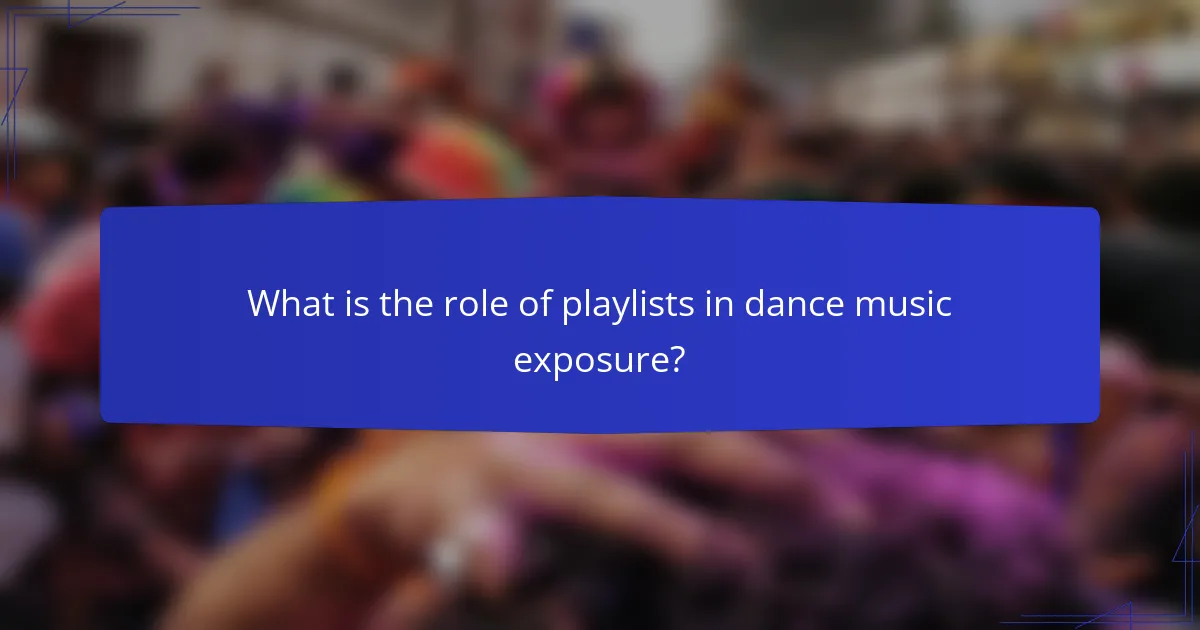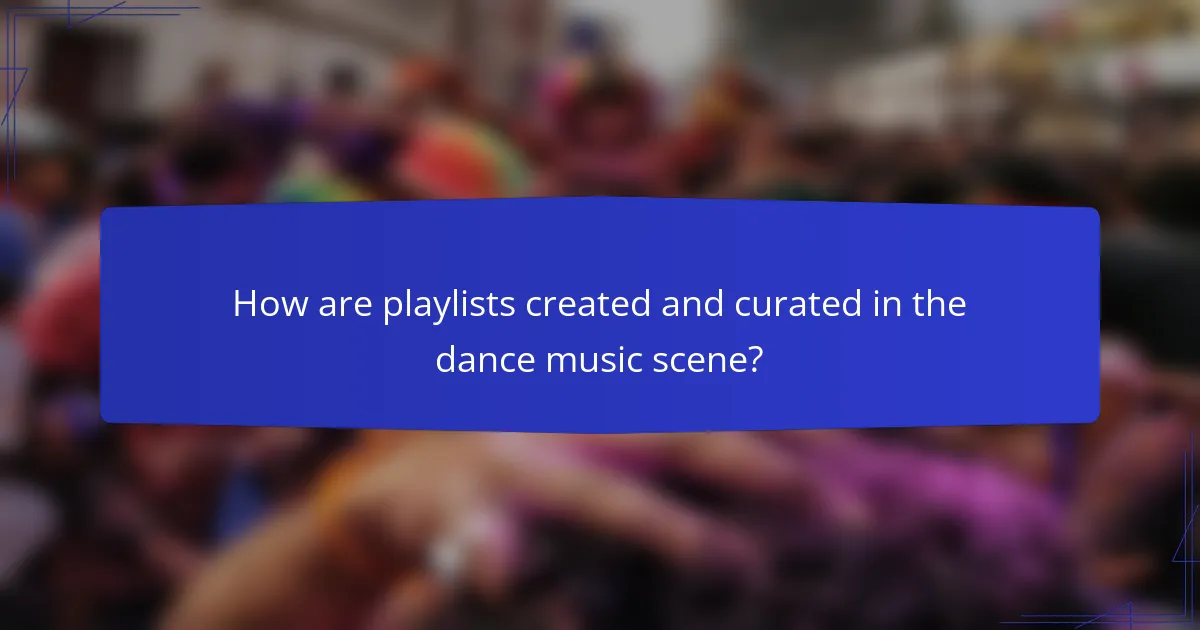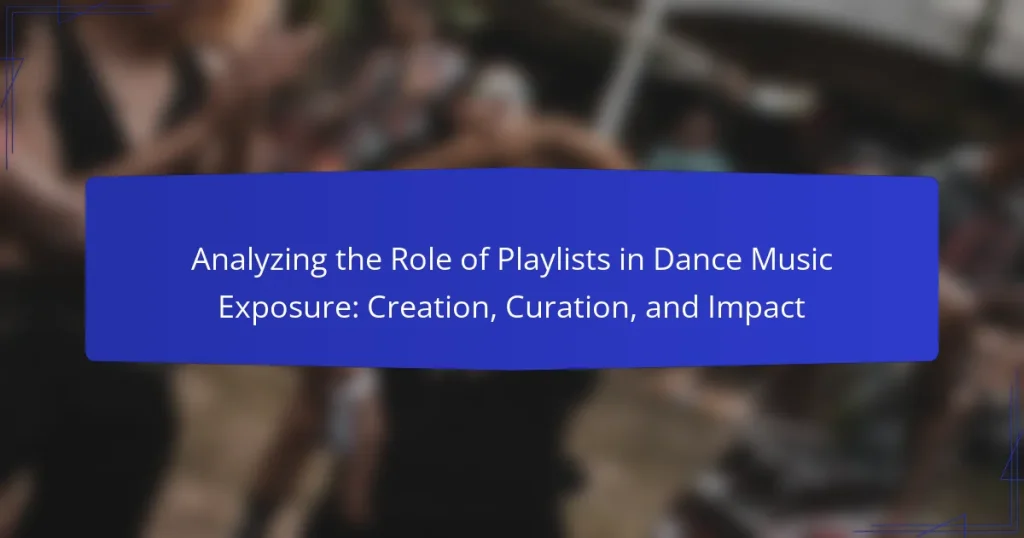Playlists are a vital entity in the dance music industry, serving as a primary method for curating and promoting tracks to a broader audience. They facilitate music discovery, enhance artist exposure, and influence listener preferences through a combination of artist selection, audience engagement, and algorithmic recommendations. The article analyzes how playlists impact streaming numbers, chart performance, and industry trends, highlighting their role in supporting emerging artists and shaping the competitive landscape of dance music. Additionally, it examines the dynamic processes behind playlist creation and curation, emphasizing the importance of relevance in an ever-evolving genre.

What is the role of playlists in dance music exposure?
Playlists play a crucial role in dance music exposure by curating and promoting tracks to a wider audience. They facilitate music discovery for listeners who may not actively seek out new artists. Playlists on streaming platforms often feature trending dance tracks, increasing their visibility. This exposure can lead to higher streaming numbers and greater fan engagement. Data shows that songs featured on popular playlists can experience a significant boost in streams, often leading to chart success. Additionally, playlists help establish genre trends and influence listener preferences. Artists often rely on playlist placements for career growth and recognition in the competitive dance music scene.
How do playlists influence the discovery of dance music?
Playlists significantly influence the discovery of dance music by curating and promoting specific tracks to listeners. They provide a structured way for users to explore new music within a genre. Streaming platforms like Spotify and Apple Music utilize algorithms to suggest playlists based on user preferences. This algorithmic curation increases exposure to emerging artists and tracks. According to a 2021 report by the International Federation of the Phonographic Industry, playlists account for over 30% of music discovery. This highlights their role in shaping listener habits and preferences. Playlists also facilitate social sharing, allowing users to recommend dance music to their networks. As a result, playlists act as a powerful tool for both artists and listeners in the dance music scene.
What are the key characteristics of effective dance music playlists?
Effective dance music playlists feature a cohesive flow, varied tempo, and engaging transitions. Cohesive flow ensures tracks blend seamlessly, maintaining listener interest. Varied tempo keeps the energy dynamic, catering to different moods and moments. Engaging transitions enhance the listening experience, preventing abrupt changes that disrupt immersion. Additionally, effective playlists reflect current trends and include a mix of popular and lesser-known tracks. This balance introduces listeners to new artists while satisfying familiar tastes. Regular updates to the playlist keep content fresh and relevant, encouraging repeat listens.
How do user-generated playlists differ from algorithmic playlists?
User-generated playlists are created by individuals based on personal preferences. In contrast, algorithmic playlists are generated by automated systems using data analytics. User-generated playlists reflect the unique tastes and moods of their creators. Algorithmic playlists rely on patterns from user behavior and listening history. The curation process for user-generated playlists is subjective and creative. Algorithmic playlists are objective and data-driven, often aiming for broader appeal. User-generated playlists can foster community and personal expression. Algorithmic playlists typically focus on maximizing engagement and retention metrics.
Why are playlists important for dance music artists?
Playlists are crucial for dance music artists as they enhance visibility and audience reach. They serve as curated collections that introduce listeners to new tracks and artists. This exposure can lead to increased streams and downloads. According to a report by Nielsen Music, playlists account for over 30% of all music streams. Artists featured in popular playlists often experience a significant boost in their listener base. Additionally, playlists help in building a fan community around an artist’s work. They also influence music discovery, making it easier for fans to find similar genres. Overall, playlists play a vital role in the marketing strategy of dance music artists.
How do playlists affect an artist’s reach and visibility?
Playlists significantly enhance an artist’s reach and visibility. They serve as curated collections of music that expose listeners to new artists. When an artist’s track is included in a popular playlist, it can lead to increased streams and followers. For instance, Spotify’s algorithmic playlists often boost tracks, resulting in substantial listener engagement. According to Spotify, tracks featured in playlists can experience a 30% increase in streams. This exposure can translate into more concert ticket sales and merchandise purchases. Furthermore, playlists can help artists reach diverse demographics, expanding their fan base. Overall, playlists are crucial tools for artists aiming to elevate their presence in the music industry.
What role do playlists play in an artist’s marketing strategy?
Playlists are crucial in an artist’s marketing strategy. They enhance visibility and reach by placing music in front of new audiences. Curated playlists often feature popular tracks, increasing streaming numbers. This exposure can lead to higher chart positions and more significant fan engagement. Playlists also help in establishing an artist’s brand identity. They allow artists to connect with listeners through themed or mood-based selections. Data shows that tracks on popular playlists can see a 10 to 20 times increase in streams. Therefore, playlists are an essential tool for driving an artist’s growth and success in the music industry.

How are playlists created and curated in the dance music scene?
Playlists in the dance music scene are created and curated through a combination of artist selection, audience engagement, and algorithmic recommendations. Curators often include DJs, producers, and music influencers who select tracks based on genre trends and personal taste. Audience feedback plays a crucial role, as listeners can influence which songs gain popularity. Streaming platforms utilize algorithms to analyze user behavior, suggesting tracks that align with listeners’ preferences. Additionally, curated playlists often reflect current events, festivals, and emerging artists. This dynamic process helps maintain relevance within the rapidly evolving dance music landscape.
What are the common methods for creating dance music playlists?
Common methods for creating dance music playlists include genre classification, mood-based selection, and crowd-sourced recommendations. Genre classification involves grouping tracks by specific styles like house, techno, or trance. Mood-based selection curates songs that evoke particular feelings, such as energetic or relaxed vibes. Crowd-sourced recommendations gather input from listeners and music communities to discover popular tracks. Additionally, algorithmic curation uses data-driven insights to suggest songs based on user preferences and listening history. These methods enhance the overall listening experience and ensure playlists resonate with audiences.
How do curators select tracks for dance music playlists?
Curators select tracks for dance music playlists based on several criteria. They consider the genre, tempo, and energy level of each track. Popularity and streaming numbers also influence their choices. Curators pay attention to emerging artists and new releases to keep playlists fresh. They often analyze listener engagement metrics to understand what resonates with audiences. Additionally, curators may align tracks with specific themes or moods. Collaboration with DJs and industry insiders can provide valuable insights. Ultimately, the goal is to create a cohesive listening experience that captures the essence of dance music.
What tools and platforms are used for playlist creation?
Playlist creation tools and platforms include Spotify, Apple Music, and YouTube. Spotify allows users to create and share playlists easily. Apple Music offers curated playlists and user-generated options. YouTube enables playlist creation for videos and music tracks. Other platforms include Tidal and SoundCloud, which also support playlist functionalities. These platforms provide features like collaborative playlists and algorithmic recommendations. User engagement is high on these platforms, enhancing music discovery.
Why is curation important in the context of dance music playlists?
Curation is important in the context of dance music playlists because it enhances listener experience and engagement. Curated playlists provide a cohesive flow of tracks that resonate with specific moods or themes. This intentional selection helps listeners discover new artists and genres. According to a study by Nielsen Music, 60% of listeners prefer playlists that are curated over algorithm-generated ones. Curation also allows for the inclusion of diverse sounds, promoting underrepresented artists. Engaging curators can build a loyal audience by establishing a unique musical identity. Overall, curation plays a crucial role in shaping the dance music landscape.
How does curation impact the quality of a playlist?
Curation significantly enhances the quality of a playlist by ensuring a thoughtful selection of tracks. Curators analyze music trends and audience preferences to create cohesive listening experiences. This process filters out lower-quality or irrelevant songs. Research indicates that well-curated playlists lead to higher listener satisfaction and engagement. According to a study by Spotify, curated playlists increase song discovery by 30%. Effective curation also maintains a consistent mood or theme, which keeps listeners engaged longer. Overall, curation plays a crucial role in elevating the overall value of a playlist.
What are the challenges faced by curators in the dance music genre?
Curators in the dance music genre face several challenges. One significant challenge is the saturation of content. The dance music scene has an overwhelming number of tracks released daily. This makes it difficult for curators to identify standout pieces. Another challenge is the diversity of sub-genres. Curators must stay informed about various styles to cater to different audiences. Additionally, curators face competition from algorithms. Streaming platforms increasingly use automated systems to create playlists. This reduces the visibility of human-curated selections. Another issue is copyright and licensing complexities. Curators must navigate legal restrictions when including tracks. Lastly, audience engagement is a challenge. Curators need to continuously adapt to changing listener preferences. These factors collectively complicate the curation process in the dance music genre.

What is the impact of playlists on the dance music industry?
Playlists significantly impact the dance music industry by enhancing artist exposure and audience engagement. They curate popular tracks, making them easily accessible to listeners. This accessibility leads to increased streaming numbers for featured artists. Playlists often dictate chart performance and can propel songs to viral status. For example, Spotify’s “Today’s Top Hits” playlist has been instrumental in launching numerous dance tracks. Additionally, playlists help emerging artists gain traction in a competitive market. The growing reliance on playlists shapes industry trends and influences music consumption patterns. Overall, playlists serve as a crucial tool for both promotion and discovery in the dance music landscape.
How do playlists shape trends in dance music?
Playlists shape trends in dance music by curating and promoting specific tracks to listeners. They influence listener preferences through algorithmic recommendations and curated selections. Playlists like Spotify’s “Today’s Top Hits” can propel songs to mainstream success. This exposure increases streaming numbers and radio play, which further solidifies a track’s popularity. For example, the rise of the song “Dance Monkey” by Tones and I was significantly boosted by its inclusion in popular playlists. Additionally, playlists often reflect current musical trends, making them a barometer for emerging styles. As a result, artists adapt their music to align with these trends, creating a feedback loop. This dynamic relationship between playlists and dance music trends drives innovation and shifts in the genre.
What metrics are used to measure the success of dance music playlists?
Metrics used to measure the success of dance music playlists include stream counts, listener engagement, and follower growth. Stream counts reflect how many times tracks in the playlist have been played. Listener engagement can be measured through likes, shares, and comments on the playlist. Follower growth indicates how many new users subscribe to the playlist over time. Other important metrics are playlist placements on popular platforms and the overall reach of the playlist. These metrics help assess the impact and popularity of dance music playlists within the music industry.
How do playlists influence listener behavior and preferences?
Playlists significantly influence listener behavior and preferences by curating music experiences. They shape the way listeners discover new tracks and artists. Playlists often introduce users to genres they may not explore independently. This exposure can shift musical taste over time. Data shows that listeners frequently engage with playlists over individual tracks. For instance, Spotify reported that over 30% of users discover new music through curated playlists. Additionally, playlists can reinforce emotional connections to songs, enhancing listener loyalty. The personalization of playlists also tailors content to individual preferences, further influencing behavior.
What are the future trends for playlists in dance music?
Future trends for playlists in dance music include increased personalization and algorithm-driven curation. Streaming platforms are leveraging AI to analyze listener preferences. This technology allows for more tailored playlist recommendations. Collaborative playlists are gaining popularity among users. They enable shared music experiences and community engagement. Genre-blending playlists are also on the rise. These playlists combine various styles, appealing to diverse audiences. Additionally, short-form playlists are becoming common, catering to listeners with limited time. The integration of social media features will enhance playlist sharing and discovery. These trends reflect the evolving landscape of dance music consumption.
How might technology change the way playlists are curated?
Technology will significantly change how playlists are curated by utilizing algorithms and artificial intelligence. These tools can analyze listener preferences and behaviors in real-time. For instance, streaming platforms like Spotify use machine learning to recommend songs based on user activity. This personalized approach enhances user experience and engagement. Additionally, technology allows for automated playlist generation, reducing the need for human curators. Data analytics can identify trending tracks and emerging artists quickly. As a result, playlists can reflect current musical trends more accurately. Overall, technology streamlines the curation process and creates more tailored listening experiences.
What role will social media play in the evolution of dance music playlists?
Social media will significantly influence the evolution of dance music playlists. It serves as a platform for artists to promote their music directly to fans. Social media allows for real-time feedback and interaction between artists and listeners. This interaction can shape playlist curation based on audience preferences. Algorithms on platforms like Spotify and Apple Music can analyze social media trends to suggest popular tracks. Additionally, viral challenges and trends on platforms like TikTok can propel certain songs into mainstream playlists. The integration of user-generated content will also diversify playlist selections. Overall, social media acts as a catalyst for the discovery and dissemination of dance music.
What best practices can artists follow to leverage playlists effectively?
Artists can leverage playlists effectively by focusing on strategic placement and audience engagement. They should research and target playlists that align with their genre and style. Engaging with playlist curators through social media can foster connections. Creating their own playlists featuring their music alongside similar artists can enhance visibility. Regularly updating their music catalog keeps their sound fresh and relevant. Utilizing metadata effectively ensures their tracks are discoverable. Collaborating with other artists can introduce their music to new audiences. Finally, monitoring analytics helps artists understand their audience and refine their strategies. These practices are supported by the growing trend of playlists driving music discovery, as evidenced by statistics showing that over 30% of listeners discover new music through curated playlists.
The main entity of the article is ‘playlists’ in the context of dance music exposure. The article analyzes the critical role playlists play in promoting dance music, enhancing artist visibility, and influencing listener behavior. It discusses the methods of playlist creation and curation, distinguishing between user-generated and algorithmic playlists, and highlights the importance of effective curation for listener engagement. Additionally, it explores the impact of playlists on the dance music industry, including trends, metrics for success, and future developments influenced by technology and social media. Overall, the content emphasizes how playlists serve as essential tools for music discovery and artist marketing within the dance music genre.
